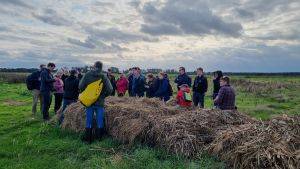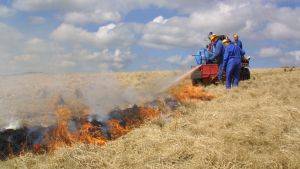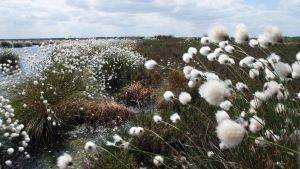Re-wetting Alkaline Fens in Brandenburg
Introduction
From 2010 to 2015 Naturschutzfonds Brandenburg is leading the EU LIFE Nature Project. Alkaline Fens in Brandenburg, which aims to restore the condition of alkaline fens in 14 Natura-2000 areas in the federal state of Brandenburg
Description
200 years ago alkaline fens were quite common in north-eastern Germany. Since then however, the changing profitability of agriculture has had a big impact. When profitable to do so, drainage ditches were used to make the fens arable so they could provide feed and bedding for cattle and other animals. When this was no longer financially beneficial on small und difficult sites, most of the fens were left to themselves. However the drainage ditches were still functioning, causing degradation and mineralisation of the peat soils. The increased availability of nutrients in combination with the lower water levels allowed reed, willow shrubbery and woods to overgrow the fens, dramatically altering the naturally open landscapes.Alkaline fens are mostly developed on spring and percolation mires. They are nurtured by mesotrophic, slightly alkaline ground water and characterised by a rich diversity of plant species, e.g. Menyanthes trifoliata, Succisa pratensis, Dactylorhiza incarnata, Liparis loeselii and Epipactis palustris. Brown mosses such as Drepanocladus vernicosus, Paludella squarrosa, Helodium blandowii and Scorpidium scorpidium are particularly characteristic. The main threats to these sensitive habitats are fluctuating water tables or water tables below ground surface, which lead to increased eutrophication. As a result, this project aims to remove nutrients and stabilise the water tables close to the surface level.
Restoration Delivered
To reduce nutrient impacts in the fens, the first step is biomass removal. Due to the difficult conditions on the wet and sensitive peaty soils specialist machines called “PistenBullys” are used for mowing and shrub removal in some project areas. In other areas, the project has worked in collaboration with local farmers to initiate a different approach, using Asian water buffalos to graze the wet meadows, keeping reed and other larger vegetation to a minimum level. To improve the hydrologic conditions of the fen, the entire drainage system has to be deactivated. On sloped fens, the ditches are completely filled using degraded peat. The top peat layer is cut to a depth of 15-20 cm and to prevent the formation of new coherent drainage channels, small dams are left along the contour lines. These dams hold any water and provide starting points for the fen vegetation to settle into the new raw-soil locations. Farmers and their families have lived and worked with moors and fens over centuries, mowing the difficult areas by hand. But after the formation of the GDR in the 1960s, family farms in Brandenburg were merged into large farming cooperatives (LPGs) and interest in small and difficult fen areas declined. To gain support for conservation activities, the project team approached local people directly and took an informal approach, holding discussions around kitchen tables to explain the importance of fens to owners and farmers. Restoration measures have been carried out in six project areas and initial results are good. 150 ha of reed have been mowed, 27 km of drainage ditches have been filled and peat has been cut on an area of about 14 ha. Water buffalos are grazing more than 30 ha. Monitoring of the hydrologic condition shows that water levels in the rewetted areas have mostly risen to the ground surface and fluctuations have been reduced significantly. Furthermore, a couple of months following these restoration measures, the project identified fen species in some areas.
Project Name: Re-wetting Alkaline Fens in Brandenburg
Organisation / Lead partner: Naturschutzfonds Brandenburg
Predominately: Upland









